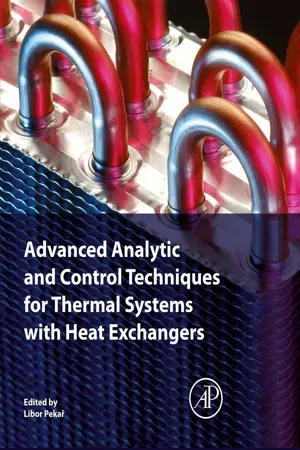
Advanced Analytic and Control Techniques for Thermal Systems with Heat Exchangers
- 519 pages
- English
- ePUB (mobile friendly)
- Available on iOS & Android
Advanced Analytic and Control Techniques for Thermal Systems with Heat Exchangers
About This Book
Advanced Analytic Control Techniques for Thermal Systems with Heat Exchangers presents the latest research on sophisticated analytic and control techniques specific for Heat Exchangers (HXs) and heat Exchanger Networks (HXNs), such as Stability Analysis, Efficiency of HXs, Fouling Effect, Delay Phenomenon, Robust Control, Algebraic Control, Geometric Control, Optimal Control, Fuzzy Control and Artificial Intelligence techniques. Editor Libor Pekar and his team of global expert contributors combine their knowledge and experience of investigated and applied systems and processes in this thorough review of the most advanced networks, analyzing their dynamics, efficiency, transient features, physical properties, performance, feasibility, flexibility and controllability. The structural and dynamic analyses and control approaches of HXNs, as well as energy efficient manipulation techniques are discussed, in addition to the design of the control systems through the full life cycle. This equips the reader with an understanding of the relevant theory in a variety of settings and scenarios and the confidence to apply that knowledge to solve problems in an academic or professional setting.Graduate students and early-mid career professionals require a robust understanding of how to suitably design thermal systems with HXs and HXNs to achieve required performance levels, which this book offers in one consolidated reference. All examples and solved problems included have been tried and tested, and these combined with the research driven theory provides professionals, researchers and students with the most recent techniques to maximize the energy efficiency and sustainability of existing and new thermal power systems.
- Analyses several advanced techniques, the theoretical background of these techniques and includes models, examples and results throughout
- Focusses on advanced analytic and control techniques which have been investigated or applied to thermal systems with HXs and HXNs
- Includes practical applications and advanced ideas from leading experts in the field, as well as case studies and tested problems and solutions
Frequently asked questions
Information
Introduction to heat exchangers
Abstract
Keywords
1 Introduction
2 Heat exchangers classification
2.1 Classification according to the functional point of view
- (i) Recuperative HXs
- (ii) Regenerative HXs
- (iii) HXs with direct mixing
2.1.1 Recuperative HXs
Table of contents
- Cover image
- Title page
- Table of Contents
- Copyright
- Contributors
- About the editor
- Preface
- Acknowledgments
- Section 1: Fundamentals of heat exchangers
- Section 2: Modeling and parameter identification for heat exchangers
- Section 3: Stability and dynamic behavior analysis
- Section 4: The efficiency of heat exchangers
- Section 5: The effect of fouling
- Section 6: Time-delay phenomenon
- Section 7: Fuzzy logic and artificial intelligence in heat exchanger design and control
- Section 8: Other modern control approaches
- Section 9: Optimal design and multiobjective optimization techniques
- Section 10: Applications of recent analytic and control methods for heat exchanger systems
- Index